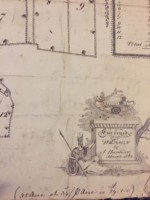
The Pig & Whistle:
We have some reference to the Pig & Whistle being open for business in the late 1800s but otherwise, we have very little information – if you can add to this we would love to hear from you (please use the contact button, above).
The Pig & Whistle stood on the corner of Folly Hall Lane in the parish of Hickling – it was on the Nottingham side of the lane; the only remaining sign of it is a circle of trees which still remain. It was never licensed and burned down, possibly at the end of the century.
Samuel Wright was a prominent resident of Upper Broughton in the early 1800s and it is likely that Colonel’s Lane was named after him. When he died, his Will outlines land belonging to him in the Parish of Hickling; he left everything to his wife, Anne Wright and his Will included the paragraph: “I also give devise and bequeath all those my other freehold messuages and tenements with the close and appurtenances thereto belonging situate lying and being in the parish of Hickling in the said County of Nottingham and now in the occupation of Anne Collishaw John Hickling and John Marsh all of which I purchased of John Wild of Over Broughton aforesaid”
We are very grateful to the Upper Broughton Local History Group for sharing their research on Samuel Wright: Samuel Wright’s prayer book found its way into the collection of Father Edward Martin, a priest in Grimsby, who then contacted the local history group about it. Fascinatingly, the prayer book contains beautiful hand drawn maps of Samuel Wright’s land on Folly Hall Lane by J. (possibly Joseph) Harding and dated 1822; he is thought to have been a local man.
- The farmhouse shown in land parcel (1) subsequently became the Pig & Whistle public house.
- The track marked, ‘To Willoughby’ is Folly Hall Lane; although it no longer goes all the way to Willoughby.
- Samuel Wright died in 1839 and, at present, we don’t know at what point, after this, the farmhouse became The Pig & Whistle.
- J Harding also drew a full map of Upper Broughton (named Over Broughton at the time). The burial of a Joseph Harding is recorded in Upper Broughton in 1847.
- Samuel’s widow, Anne Wright, remarried in 1846 but was widowed again in 1857. She died in 1866. It may be as a result of her death that the farmhouse changed hands and became a public house.
- The trees which are the only remaining sign of the farmhouse/public house appear to be the remnants of an old orchard.










